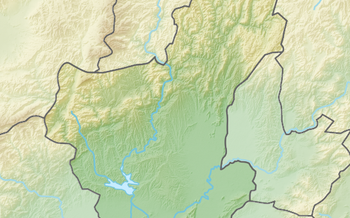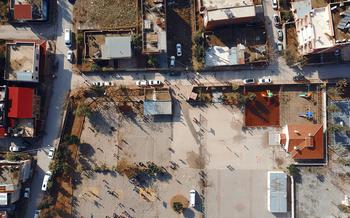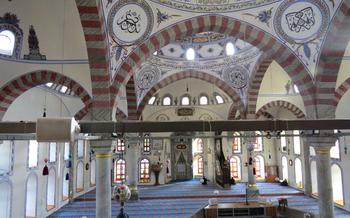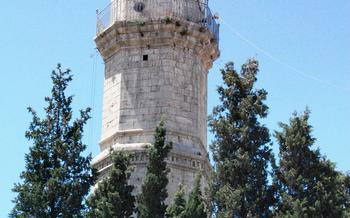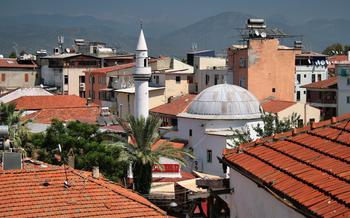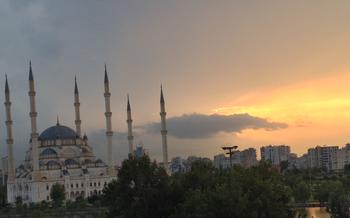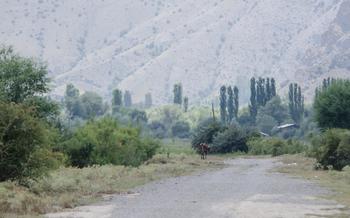
Sar Cami (Yellow Mosque)
- Sar Cami (Yellow Mosque) in Adana, Turkey: A Historical and Architectural Marvel
- The History of Sar Cami: A Legacy of Faith
- Unique Architectural Features: A Blend of Styles
- A Place of Worship and Community: The Heart of the Neighborhood
- Religious Importance and Symbolism: A Beacon of Faith
- Weekday Explorations: Unveiling the Mosque's Tranquility
- Respectful Attire: Honoring Local Customs
- Footwear Etiquette: Removing Shoes Before Entering
- Interior Exploration: Discover Hidden Gems
- Photography Etiquette: Capturing Memories Respectfully
- Local Insights: Engaging with the Community
- Educational Programs: Unveiling Islamic Heritage
- Nearby Attractions: Exploring Adana's Treasures
- Local Cuisine: Tantalizing Adana Flavors
- Insider Tip: Unveiling Hidden Beauty
Sar Cami (Yellow Mosque) in Adana, Turkey: A Historical and Architectural Marvel
The Sar Cami, also known as the Yellow Mosque, stands as a majestic testament to the rich history and architectural heritage of Adana, Turkey. Constructed during the reign of the Ramazanoğulları dynasty in the 16th century, the mosque holds immense cultural and religious significance for the local community. Its striking yellow stone exterior and intricate tilework make it a captivating sight, attracting visitors from near and far. The mosque serves as a vibrant center for daily prayers and Islamic education, contributing to the vibrant spiritual life of Adana. With its unique architectural features and deep-rooted religious symbolism, the Sar Cami invites travelers to embark on a journey through time, exploring the captivating fusion of faith and art that defines this remarkable landmark.
The History of Sar Cami: A Legacy of Faith
The Sar Cami, also known as the Yellow Mosque, proudly stands as a testament to the rich Islamic heritage of Adana. Its construction dates back to the 16th century, during the reign of the Ramazanoğulları dynasty, a prominent local dynasty that ruled over the city and its surroundings. The mosque's foundation marked a significant milestone in Adana's architectural and cultural landscape, solidifying its position as a vibrant center of Islamic devotion.
The Ramazanoğulları dynasty, known for their patronage of the arts and architecture, commissioned the construction of the Sar Cami to serve as a central place of worship for the growing Muslim community in Adana. The mosque's intricate design, incorporating elements of Seljuk and Ottoman architecture, reflected the dynasty's commitment to preserving and enriching Islamic traditions.
Over the centuries, the Sar Cami has undergone several renovations and expansions, each contributing to its architectural grandeur. These renovations not only ensured the mosque's structural integrity but also showcased the evolving artistic and cultural influences that shaped Adana's cityscape. Today, the Sar Cami stands as a symbol of Adana's Islamic heritage, a testament to the enduring faith and devotion of its people.
Unique Architectural Features: A Blend of Styles
The Sar Cami stands out with its distinctive architectural features, reflecting a harmonious blend of Seljuk and Ottoman influences. Its striking yellow stone exterior, a result of the abundant use of local Adana stone, gives the mosque its popular name, "Yellow Mosque." The intricate carvings and decorative elements adorning the facade, including floral motifs and geometric patterns, showcase the exceptional craftsmanship of the era. The slender minaret, with its elegant conical shape and intricate tilework, rises gracefully into the sky, serving as a prominent landmark in the city's skyline. The mosque's dome, adorned with turquoise tiles, adds to its visual splendor and complements the overall design.
Inside the mosque, visitors are greeted by a serene and awe-inspiring space. The interior features a harmonious blend of Seljuk and Ottoman architectural elements. The walls are adorned with intricate tilework, featuring vibrant colors and geometric patterns. The mihrab, a prayer niche indicating the direction of Mecca, is particularly noteworthy, featuring intricate carvings and decorative elements. The minbar, a pulpit used for delivering sermons, is another highlight, showcasing fine craftsmanship and elegant design. The overall ambiance of the Sar Cami's interior evokes a sense of spirituality and invites contemplation.
A Place of Worship and Community: The Heart of the Neighborhood
The Sar Cami is not merely a place of worship but also serves as the heart of the surrounding neighborhood. Muslims in Adana gather here daily to offer prayers, seeking solace and connection with their faith. The mosque plays a pivotal role in fostering a sense of community, providing a space for religious education and various social events. It is a place where people come together to celebrate Islamic holidays, share joys, and offer support during times of need. The mosque's presence contributes to the vibrant spiritual life of Adana, enriching the cultural identity of the city and strengthening the bonds among its Muslim residents.
Religious Importance and Symbolism: A Beacon of Faith
For Muslims in Adana, the Sar Cami holds immense religious significance. It stands as a symbol of Islamic devotion and heritage, embodying the deep-rooted faith of the community. The mosque represents religious identity and unity, serving as a focal point for spiritual gatherings and celebrations. Its presence in the city's landscape serves as a reminder of the enduring strength of Islamic traditions, contributing to the cultural and spiritual fabric of Adana. The Sar Cami's architectural beauty and historical significance make it a cherished landmark, symbolizing the city's rich Islamic heritage and its enduring connection to the faith.
Weekday Explorations: Unveiling the Mosque's Tranquility
To truly experience the serene essence of the Sar Cami, consider visiting on a weekday. During this time, the mosque is less crowded, allowing you to explore its tranquil atmosphere without distractions. Engage with local worshippers, who are often more than willing to share insights into the mosque's history and significance. Immerse yourself in the spiritual ambiance, marveling at the intricate details of the architecture and the harmonious sounds of prayers echoing through the prayer hall. Weekday visits offer a unique opportunity to connect with the soul of the mosque and gain a deeper understanding of its role in the community.
Respectful Attire: Honoring Local Customs
When visiting the Sar Cami, it is important to dress modestly to show respect for Islamic traditions and customs. This means covering your shoulders, knees, and chest, regardless of gender. Avoid wearing revealing or tight clothing, as this may be considered disrespectful. By dressing appropriately, you can demonstrate your understanding and appreciation for the local culture, ensuring a positive and enriching experience for all.
Footwear Etiquette: Removing Shoes Before Entering
In keeping with Islamic customs, it is customary to remove one's shoes before entering the Sar Cami. This practice serves as a sign of respect for the sanctity of the prayer space, acknowledging the mosque as a sacred place of worship. Upon entering the mosque, designated shoe racks are provided for the safekeeping of your footwear. Embracing this practice is not only a demonstration of cultural sensitivity but also an opportunity to immerse yourself in the local traditions and customs. By removing your shoes, you join the community in honoring the sacred nature of the mosque and contribute to the preservation of its pristine environment.
Interior Exploration: Discover Hidden Gems
Step inside the Sar Cami and prepare to be captivated by its intricate details and serene ambiance. Admire the magnificent tilework that adorns the walls and mihrab, each tile meticulously hand-painted with intricate patterns and vibrant colors. The mihrab, the niche indicating the direction of Mecca, is a masterpiece of Islamic art, featuring intricate carvings and calligraphy.
Take a moment to explore the serene courtyard, where the soothing sound of water from the ablution fountain creates a tranquil atmosphere. The courtyard is surrounded by elegant arches and columns, adding to the mosque's architectural charm. As you enter the prayer hall, let the grandeur of the space wash over you. The high ceiling, supported by rows of stately columns, creates a sense of awe and reverence. The soft light filtering through the stained-glass windows casts a warm glow upon the intricate carpets that cover the floor.
Photography Etiquette: Capturing Memories Respectfully
Capturing the beauty of the Sar Cami through photography is a wonderful way to preserve your memories of this stunning mosque. However, it is important to remember that you are visiting a place of worship, and as such, there are certain guidelines to follow when taking photos.
First and foremost, always seek permission before taking any photographs, especially during prayer times. This is a sign of respect for the worshippers and will ensure that you do not disrupt their devotions. Be mindful of where you are pointing your camera and avoid taking close-up shots of individuals without their consent.
It is also important to be respectful of the privacy of others. Avoid taking photos of people who are praying or engaged in other religious activities. If you do want to capture a photo of someone, be sure to ask their permission first.
Finally, remember that the Sar Cami is a place of worship, not a tourist attraction. While it is perfectly acceptable to take photos, it is important to do so in a way that is respectful of the sanctity of the space.
Local Insights: Engaging with the Community
Venturing beyond the mosque's architectural wonders, engage with the welcoming locals who are eager to share their stories and perspectives. Initiate conversations, ask questions about the mosque's history, and seek their insights into the significance of this sacred space in their daily lives. Share your own experiences and create a genuine connection that transcends cultural boundaries. Embrace this opportunity for cultural exchange, where you'll gain a deeper understanding of the local way of life and the vibrant tapestry of Adana's community.
Educational Programs: Unveiling Islamic Heritage
In addition to exploring the Sar Cami's architectural and religious significance, visitors can delve deeper into Islamic heritage through educational programs and guided tours. These programs provide an opportunity to learn about the history, architecture, and traditions of Islam, as well as the role of mosques in Turkish society. Visitors can gain insights into the cultural and religious significance of the Sar Cami and its contributions to Adana's Islamic heritage.
Inquire at the mosque or local tourism offices about available educational programs or guided tours. These programs often offer expert insights, historical context, and cultural explanations, allowing visitors to gain a deeper understanding and appreciation for the Sar Cami and its place in Turkish Islamic culture. Embrace this opportunity to enrich your knowledge and understanding of this historic and sacred site.
Nearby Attractions: Exploring Adana's Treasures
Situated in the heart of Adana, the Sar Cami is surrounded by a wealth of historical and cultural attractions that offer a glimpse into the city's rich past and vibrant present. Just a short walk from the mosque, visitors can delve into the fascinating world of Adana's history at the Adana Ethnography Museum. This museum houses a diverse collection of artifacts, textiles, and traditional clothing, providing insights into the region's unique cultural heritage.
For those seeking a taste of local life, the Grand Bazaar is a must-visit destination. This bustling marketplace offers a vibrant array of goods, from traditional handicrafts to fresh produce and delectable Turkish delights. The air is filled with the sounds of haggling and the aroma of freshly brewed coffee, creating an immersive shopping experience.
Nature lovers can find solace along the scenic Seyhan River, which meanders through the city, offering picturesque views and tranquil spots for relaxation. Take a leisurely stroll along the riverbank, admiring the lush greenery and watching the world go by.
Adana's culinary scene is not to be missed, with a diverse range of restaurants serving up traditional Turkish fare and local specialties. Indulge in the tantalizing flavors of Adana kebab, a succulent grilled meat dish that is a local delicacy. Pair your meal with a refreshing glass of Turkish tea or coffee, and explore the vibrant street food scene for a taste of authentic Turkish cuisine.
Local Cuisine: Tantalizing Adana Flavors
Adana's culinary scene is renowned for its bold flavors and diverse offerings. While exploring the city, be sure to indulge in the delectable local cuisine.
One must-try dish is the Adana kebab, a flavorful grilled meat skewer that has become a symbol of the city. The succulent lamb or beef is seasoned with a blend of spices and cooked to perfection over an open fire. Pair your kebab with freshly baked bread, grilled vegetables, and a squeeze of lemon for an unforgettable culinary experience.
No visit to Adana is complete without savoring a cup of traditional Turkish coffee or tea. These beverages are deeply ingrained in Turkish culture and offer a delightful way to relax and connect with locals. Sip on a cup of strong, aromatic coffee or indulge in the soothing flavors of Turkish tea, often served with a side of Turkish delight.
Adana's vibrant street food scene is another culinary gem waiting to be explored. From gözleme, a savory pancake filled with various fillings, to kumpir, a baked potato topped with an array of ingredients, there's something to satisfy every palate. Don't miss out on the chance to sample these delicious and affordable treats as you wander through the city's bustling streets.
As you immerse yourself in Adana's local cuisine, you'll discover a rich tapestry of flavors and traditions that reflect the city's cultural heritage. From the smoky aroma of grilled kebabs to the comforting warmth of Turkish coffee, Adana's culinary offerings are sure to tantalize your taste buds and leave you craving more.
Insider Tip: Unveiling Hidden Beauty
For a truly enchanting experience, visit the Sar Cami in the evening when the sun sets and the city transforms into a magical tapestry of lights. Witness the mosque's exterior bathed in a golden glow, casting an ethereal aura against the darkening sky. Capture breathtaking photographs that encapsulate the mosque's beauty under the celestial canopy. As darkness envelops the city, the mosque's illuminated silhouette stands out as a beacon of faith, inviting visitors to immerse themselves in its spiritual ambiance. Experience the serene serenity of the mosque under the moonlight, a perfect moment for reflection and contemplation. Let the tranquility of the night enhance your appreciation for this architectural marvel, leaving you with an unforgettable memory of your visit to the Sar Cami.
